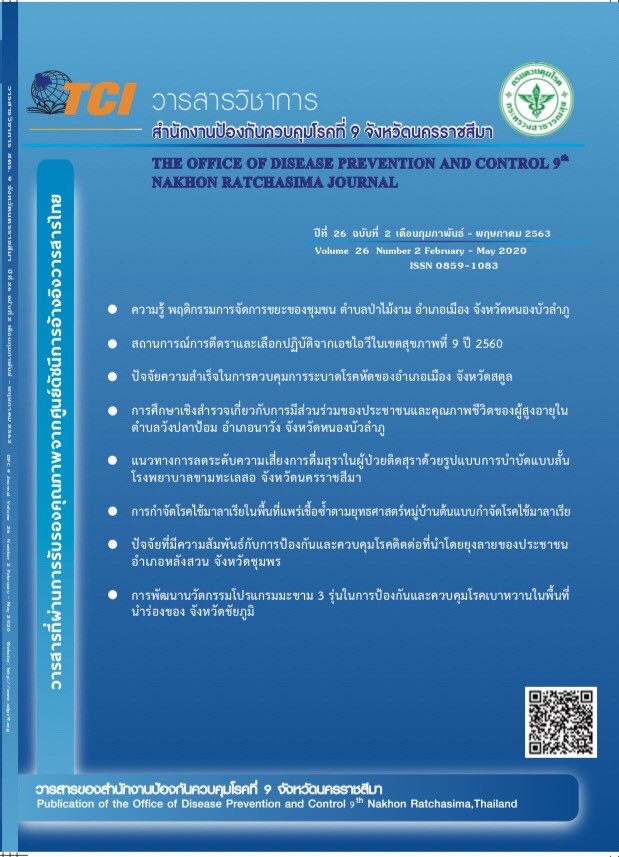Malaria Elimination in Resurgence Area according to the Strategy of Malaria Elimination Village Model
Keywords:
Development of operation, Malaria elimination village, Disease-freeAbstract
Action research was conducted in the study, its purpose was to develop malaria elimination in the resurgence area according to the strategy of the malaria elimination village model in the Huaiya sub-district, Nong Bua Ra We district, Chaiyaphum province. The samples consisted of, a first group was 35 people of the malaria elimination team, and a second was 54 people in moo 8 Klongnguluem village. Methods included 4 stages; planning, action, observation, and reflection. Data were collected by a focus group, observation, and interview. Descriptive statistics were used for quantitative data, and qualitative data were analyzed by content analysis. The results found that development of malaria elimination in resurgence area according to the strategy of malaria elimination village model included 7 steps; 1) context analysis of malaria elimination 2) malaria elimination team setting 3) training guideline, 4) problems analysis and plan 5) operation following the plan 6) monitoring and supporting 7) lesson learned. Consequently, the knowledge of people about malaria and the practice of malaria elimination was improved at a moderate level about 66.70% and 73.91% respectively. Finally, the results found that the operation could be done by following the plan and guidelines of the malaria elimination village model. Therefore, malaria was eliminated in the resurgence area.
Keywords: Development of operation, Malaria elimination village, Disease-free
References
องค์การสหประชาติประเทศไทย. เป้าหมายการพัฒนาอย่างยั่งยืนของประเทศไทย [ออนไลน์]. 2561 [วันที่ 3
ตุลาคม 2561]. เข้าถึงได้จาก website: http://www.un.or.th/globalgoals/th/the-goals/.
สำนักโรคติดต่อนำโดยแมลง กรมควบคุมโรค. ยุทธศาสตร์กำจัดโรคไข้มาลาเรียประเทศไทย พ.ศ.2560 –
, พิมพ์ครั้งที่ 1. กรุงเทพฯ: สำนักพิมพ์อักษรกราฟิคแอนดีไซน์; 2559 : 13 – 14.
สำนักโรคติดต่อนำโดยแมลง กรมควบคุมโรค. ฐานข้อมูลโรคมาลาเรียออนไลน์ [ออนไลน์]. 2561 [วันที่ 3
ตุลาคม 2561]. เข้าถึงได้จาก http://203.157.41.215/malariaR10/index_newversion.php.
ปราณ สุกุมลนันทน์. การสอบสวนการระบาดโรคไข้มาลาเรียในพื้นที่แพร่เชื้อซ้ำ อำเภอหนองบัวระเหว
จังหวัดชัยภูมิ ปี 2561. 2561. การประชุมวิชาการสาธารณสุขเขตสุขภาพที่ 9 นครชัยบุรินทร์ ครั้งที่ 18 วันที่ 19 - 20 กันยายน 2561.
สุมัทนา กลางคาร และวรพจน์ พรหมสัตยพรต. หลักการวิจัยทางวิทยาศาสตร์สุขภาพ, พิมพ์ครั้งที่ 6.
มหาสารคาม : สารคามการพิมพ์ – สารคามเปเปอร์; 2553.
สำนักโรคติดต่อนำโดยแมลง กรมควบคุมโรค. แนวทางการปฏิบัติงานควบคุมโรคไข้มาลาเรียสำหรับ
บุคลากรสาธารณสุข พ.ศ. 2552, พิมพ์ครั้ง 2 . กรุงเทพฯ : บริษัท เรดิเอชั่น จำกัด; 2552 : 18.
บุญมา อุยาสงค์. การพัฒนารูปแบบการดำเนินงานการป้องกันและควบคุมโรคมาลาเรียโดยทีม SRRT ของ
อาสาสมัครในเมืองตุ้มลาน แขวงสาละวันสาธารณรัฐประชาธิปไตยประชาชนลาว. วิทยานิพนธ์ปริญญาสาธารณสุขศาสตรมหาบัณฑิต มหาวิทยาลัยมหาสารคาม; 2557.
สมหมาย งึมประโคน และคณะ. การพัฒนารูปแบบการดำเนินงานป้องกันโรคมาลาเรียโดยการมีส่วนร่วม
ของชุมชน ตำบลหนองแวง อำเภอละหานทรายจังหวัดบุรีรัมย์. วารสารสำนักงานป้องกันควบคุมโรคที่ 7 จังหวัดนครราชสีมา. 2559; 23(1): 35–45.
Asingizwe, D. et al. Applying citizen science for malaria prevention in Rwanda: An integrated conceptual framework. NJAS - Wageningen Journal of Life Sciences. 2018.
สะใบทอง หาญบุ่งคล้า และคณะ. ปัจจัยที่มีความสัมพันธ์กับการติดเชื้อมาลาเรียที่เป็นโรคประจำถิ่นในจังหวัดราชบุรี ปี พ.ศ. 2558. วารสารควบคุมโรค. 2560; 4: 423–435.
World Health Organization. Indoor Residual Spraying. An Operational Manual for Indoor Residual
Spraying (IRS) for Malaria Transmission Control and Elimination. WHO Press: World Health Organization. 2015.

Downloads
Published
How to Cite
Issue
Section
License

This work is licensed under a Creative Commons Attribution-NonCommercial-NoDerivatives 4.0 International License.
บทความที่ลงพิมพ์ในวารสารวิชาการสำนักงานป้องกันควบคุมโรคที่ 9 จังหวัดนครราชสีมา ถือว่าเป็น
ลิขสิทธิ์ สำนักงานป้องกันควบคุมโรคที่ 9 จังหวัดนครราชสีมา



